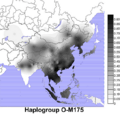East Asian languages facts for kids
The East Asian language family is a big idea that groups together many languages spoken across East Asia and Southeast Asia. Think of it like a giant family tree for languages! Scientists believe these languages might have come from a common ancestor long ago. This idea is still being studied, so it's called a "theoretical" family.
This huge group includes several well-known language families:
- The Sino-Tibetan languages, which include languages like Chinese and Tibetan.
- The Hmong-Mien languages, spoken by people in parts of China, Vietnam, Laos, and Thailand.
- The Kra-Dai languages, like Thai and Lao.
- The Austronesian languages, which spread across many islands, including languages like Malay and Tagalog.
- The Austroasiatic languages, such as Vietnamese and Khmer.
- The Koreanic languages, mainly Korean.
- And the Japonic languages, which include Japanese.
Contents
What Are Language Families?
Just like your own family has members who are related, language families connect languages that share a common origin. This means they evolved from an older "parent" language. Over thousands of years, these languages changed and spread out, becoming the different languages we hear today.
Scientists who study languages, called linguists, look for similarities in words, grammar, and sounds to figure out if languages are related. It's like being a detective, searching for clues to build a language family tree!
Major Language Families in East Asia
East Asia and Southeast Asia are home to an incredible variety of languages. Here are some of the main families that are part of the larger East Asian language family idea:
Sino-Tibetan Languages
This is one of the largest language families in the world. It includes hundreds of languages spoken by billions of people. The most famous member is Mandarin Chinese, but it also includes many other Chinese languages and languages spoken in Tibet, Myanmar, and parts of India. These languages often have tones, meaning the pitch of your voice changes the meaning of a word.
Kra-Dai Languages
The Kra-Dai family is mostly found in Southeast Asia. Important languages in this group are Thai (spoken in Thailand) and Lao (spoken in Laos). Many Kra-Dai languages also use tones. They have a rich history and are vital to the cultures of these regions.
Austronesian Languages
The Austronesian family is amazing because its speakers traveled vast distances across the ocean. Languages like Malay (spoken in Malaysia and Indonesia), Tagalog (in the Philippines), and even Hawaiian are part of this family. They spread from Taiwan thousands of years ago, reaching as far as Madagascar and Easter Island!
Austroasiatic Languages
This family includes languages like Vietnamese and Khmer (the main language of Cambodia). These languages are very important in mainland Southeast Asia. While some, like Vietnamese, have tones, others do not. They represent ancient cultures and traditions in the region.
Hmong-Mien Languages
The Hmong-Mien languages are spoken by ethnic groups mainly in mountainous areas of southern China, Vietnam, Laos, and Thailand. The most widely spoken language in this family is Hmong. These languages are known for their complex tone systems.
Koreanic Languages
The Koreanic family primarily consists of the Korean language, spoken by people in North and South Korea. While its exact relationship to other language families is still debated by some, many linguists see connections that place it within the broader East Asian group. Korean has a unique writing system called Hangul.
Japonic Languages
The Japonic family includes Japanese and the Ryukyuan languages spoken on the Ryukyu Islands of Japan. Like Korean, the exact origins of Japonic languages are a topic of ongoing research. Japanese has a complex writing system that uses characters borrowed from Chinese, along with its own phonetic scripts.
Why Study Language Families?
Studying language families helps us understand human history and migration. It shows how people moved around the world and how their cultures developed. It also helps us appreciate the incredible diversity of human communication. By looking at these connections, we learn more about ourselves and our shared past.
Images for kids
-
Dispersal of Austronesian languages



